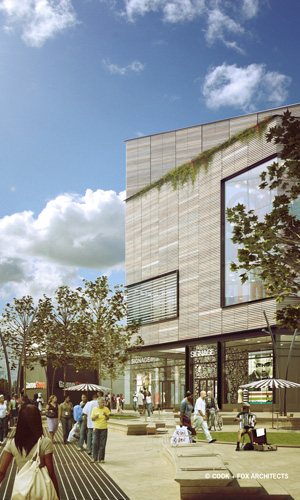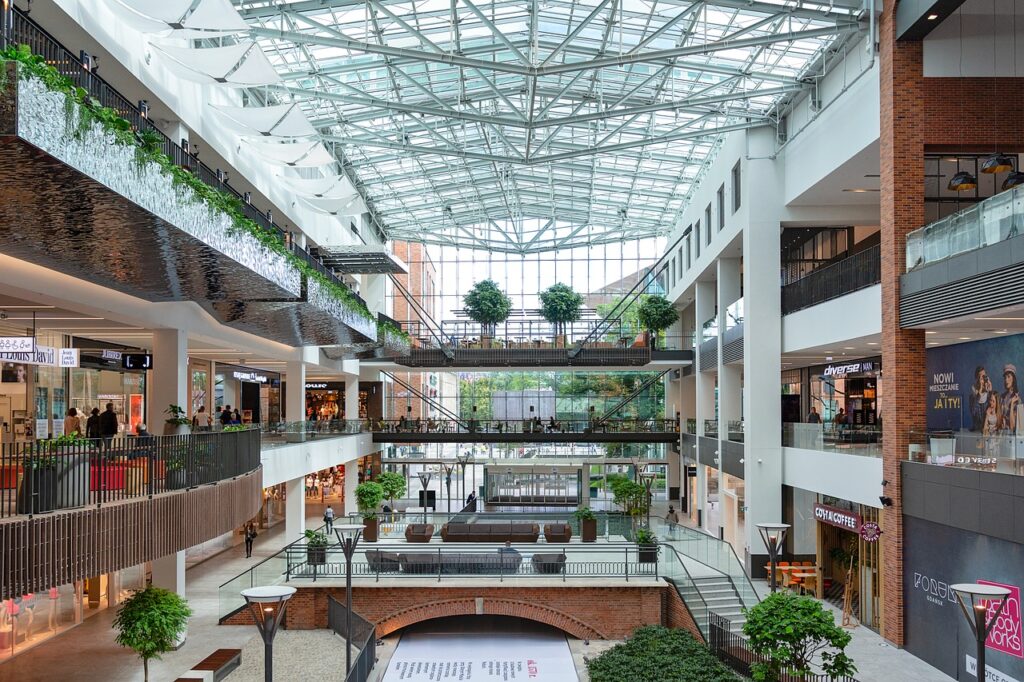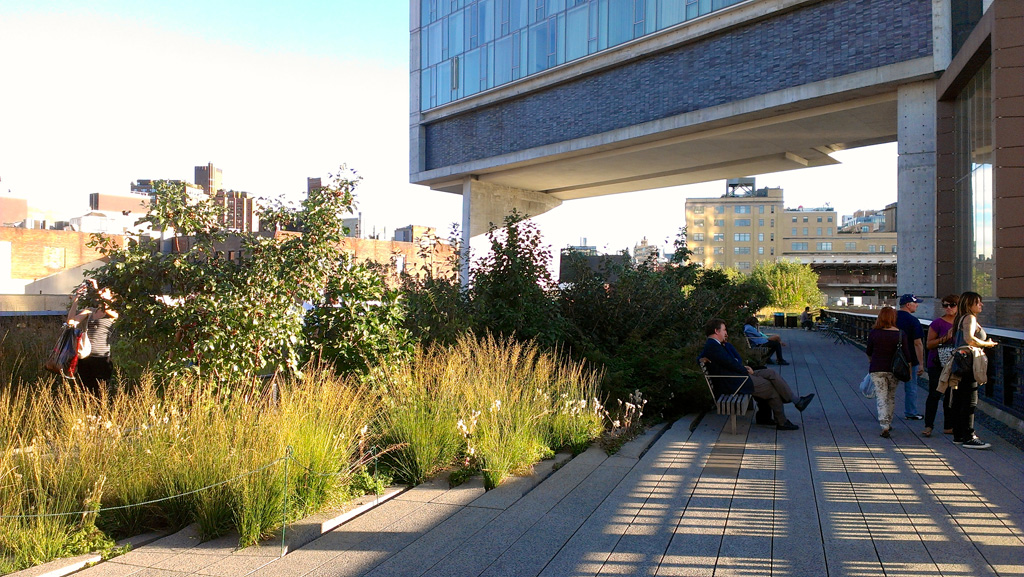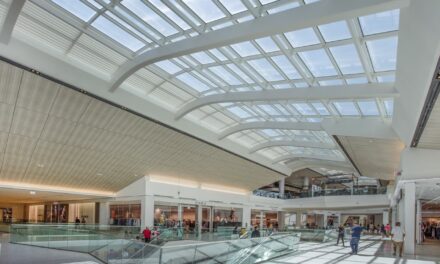In today’s society, sectors across industry are reaping the economic benefits of biophilic design. By examining five of these sectors—workplaces, healthcare, retail stores, schools, and communities—we can begin to understand the fiscal implications of biophilic design across the economy. The numbers and percentages presented reflect powerful evidence that design and planning strategies informed by nature can lead to positive impacts on human health, child development, community safety, and worker satisfaction. These effects translate directly to increased profits.
The Importance of Nature in Retail Spaces
In 2016, the average American spent $15,017 in retail sales—more than a 20% increase since 2010 (U.S. Census Bureau, 2018a). Meanwhile, the share of retail sales from e-commerce has almost doubled in that same time period (U.S. Census Bureau, 2018b). The dramatic shift to online shopping is forcing retail brands to rethink customer experience and explore new ways to breathe life into in-store shopping. Prominent retail design forecaster, KPMG, predicts that “experience per square foot” will be a key performance indicator used by retail brands in the coming years (KPMG, 2018). Walker, a customer intelligence consulting firm, furthers the prediction, proposing that “customer experience will overtake price and product as the key brand differentiator by the year 2020” (Walker, 2017).
Akin to the hospitality sector, retail space design serves many practical functions from a marketing standpoint. Exterior design elements need to attract attention and interest new customers. Interior design should elicit effective shopping practices and further exploration. Both should contribute to a positive perception of brand, increasing the acceptable price for its products. Biophilic design has been shown to support each of these goals. By acknowledging important tenets of environmental psychology in conjunction with our innate desire to affiliate with nature, biophilic retail spaces can improve occupant experience, ultimately translating into increased revenue.
Greenery

BIOPHILIA AND RETAIL
Retail customers judge businesses surrounded by nature and natural features to be worthy of prices up to 25% higher than businesses with no access to nature.
– Albee Square, Brooklyn, NY, 2010. Courtesy of COOKFOX Architects
There is evidence that consumers are likely to buy more merchandise in stores with natural vegetation. It is not a coincidence that store and mall layouts are mapped to intentionally and meticulously guide shoppers through a maze of products surrounded by strategically placed plants, trees, and skylights. The real estate industry has capitalized on our innate affinity for the savanna-like environments of our early Homo sapien ancestors—with clustered trees, semi-open spaces, refuge from the sun, water features, multiple-view corridors, and high levels of visual access—and we see these increasingly in shopping malls across the country (Heerwagen, 1998). These small yet powerful influences over consumers’ purchasing habits can help retail stakeholders capture greater profits when biophilic greening practices are employed (Joye, 2010).
In a consumer study of biophilic store designs, participants were shown photographs of retail environments and asked to measure the visual quality, place perception (judgment of products, product value, and merchant responsiveness), patronage behavior (frequency and duration of shopping actions), and price perceptions in three different types of shopping environments: green streets with high vegetation content, enclosed sidewalks with scattered greenery, and streets with no visible vegetation. The results were clear; well-tended streets with large trees received the highest preference ratings even though plants obscured some products and building facades (Wolf, 2005). Images of tidy business districts with no trees received the lowest scores. The place perception results revealed that consumers associated trees as attractive and appealing additions to their shopping experience and ranked these streets as well-maintained, friendlier, and more worthy of their dollars than the barren or enclosed sidewalk streets. Shoppers said they would stay longer once in a shop and would visit the business district more frequently—an accurate reflection of spending habits—when vegetation was heavily prevalent.
This same study reveals a compelling increase in the hedonic value of goods sold in greener areas versus retail locations that are devoid of nature. When shown images of greener retail settings, respondents indicated that an acceptable price to pay was 20% higher for an item in convenient shopping (e.g., a sandwich for lunch), 25% higher for general shopping (e.g., a new jacket or watch), and 15% more for specialty shopping (e.g., a gift for a family member) (Wolf, 2005). The addition of plant life into the realm of retail shopping appears to act as a stimulus that boosts the image perception and economic viability of stores.
Daylighting
Daylighting in the retail setting also offers an easy method for stores to dramatically boost sales. In 1993, Wal-Mart consulted with a number of sustainable design firms and institutions in an effort to design a prototype green store. Wal-Mart sought to improve energy efficiency, enhance indoor air quality, address water conservation, and increase native landscaping. In one of their prototype stores, only half of the store was daylit, but according to Wal-Mart’s former Vice President for Real Estate Tom Seay, the effort yielded remarkable insights. The sales per square foot were significantly higher for departments located in the daylit sections of the store and sales associates communicated preference for working in the daylit departments. In addition, sales in daylit departments of this new store were markedly higher than sales in the same department in other non-daylit stores (Romm & Browning, 1994).
The most extensive study linking daylighting to retail sales was conducted from 1999-2001 in a chain of 73 retail stores throughout California; 24 stores were categorized as having significant daylight illumination, whereas the remaining 49 relied on artificial light. A thorough analysis of sales reports showed, with 99% statistical accuracy, that non-skylit stores experienced a 40% increase in gross sales after the installation of skylights. The profit associated with the resulting increase in sales due to daylit areas was estimated to be at least nineteen times greater than the energy savings. As energy costs for these stores were found to be $0.24 to $0.66 per square foot less than traditionally lit stores, depending on the complexity of the monitoring system installed, the profit from the sales increase, at $4.56 to $12.54 per square foot, far overshadows energy savings. The statewide impact for California if daylighting design was adopted on a mass scale in retail environments would be over $47.5 million in increased profits and $2.5 million saved per year in energy costs (Heschong, 2003a).

From Theory to Practice
Consumer brands have increasingly experimented with these influential design strategies in their own stores. Innisfree, a skincare company based in South Korea, has leveraged biophilic design to promote a memorable customer experience and reinforce their brand identity. Their flagship store was designed to captivate shoppers with indoor greenery, multisensory art, and natural material use. In this case, a multisensory art piece—“The Cloud,” by Richard Clarkson—interacts with Innisfree patrons moving through the store with flashing lightning and thunder controlled by a person’s proximity. Customizable fragrance diffusers further immerse occupants.
The success of their flagship store design has led the way for other Innisfree locations to apply biophilic design. In Seoul, a translucent ceiling is highlighted by a captivating biomorphic ceiling art piece by SOFTlab design. The store design maximizes incoming daylight, which has been shown to act as a natural mood enhancer, with positive implications for dwell time and subsequent sales. The exterior facade features a multitude of small lights, emblematic of a waterfall cascading over the roof edge.
Daylighting has also been increasingly utilized by businesses to increase retail profits. Major corporations such as Target and Recreational Equipment Incorporated (REI) have adopted daylighting strategies for their stores. Built in 1998, Target’s entirely daylit store in Phoenix, Arizona covered its skylights for six months out of the year, operating by electric lights, to measure any difference in sales that might occur as a result of a difference in lighting quality. Unpublished estimates show sales that are 15–20% higher in the six months where the store was lit only by daylight. This data was enough incentive for Target to open a similarly designed store in Turlock, California in 2000. This store experienced similar sales patterns in comparison with a non-daylit store (Edwards & Torcelli, 2002). To generalize the data, skylights statistically increase sales by $1.55 per square foot in grocery stores, clothing outlets, and retail chains across the country (Heschong, 2003a). Extrapolating this value, the addition of skylights alone translates to an annual sales boost that can range from $62,000 in a large grocery store to over $387,000 in a supercenter. Concurrently, stores implementing these strategies are also driving down their energy costs by installing light sensors that adjust electric lighting depending on the amount of available daylight.
Biophilic retail is a growing trend at all types of venues, from outdoor retail promenades, indoor malls and flagship stores to airport concessions, restaurants, and hospitality retail amenities. By embracing daylight and greenery strategies that add ‘experiential value’ and market/brand differentiation, developers and store owners have the opportunity to optimize profit margins that are economically, environmentally, and socially savvy.
“The Economics of Biophilia” is a six-part republication of “The Economics of Biophilic Design” by Terrapin Bright Green. As a series, each section explores one of five economic indicators as it relates to biophilic design: workplace, healthcare, education, retail, and community.
Work References:
Edwards, L. & Torcelli, P. (2002). “A Literature Review on the Effects of Natural Light on Building Occupants.” National Renewable Energy Laboratory. NREL/TP-550-30769. Golden, CO.
Heerwagen, J. H. (1998). “Design, Productivity and Well Being: What are the Links?” Presented at AIA Conference on Highly Effective Facilities. Cincinnati, OH.
Heschong, L., Heschong Mahone Group. (2003a). “Daylight and Retail Sales.” California Energy Commission: Pacific Gas and Electric Company. Fair Oaks, California.
Joye, Y., Willems, K., Brengmen, M., & Wolf,K. (2010). “The effects of urban retail greenery on consumer experience.” Elsevier Science Ltd. Urban Forestry & Urban Gardening, 9, 57–64.
KPMG. (2018). “Global Retail Trends 2018.” KPMG Global Consumer & Retail team.
Romm, J.J., & Browning, W. D. (1994). “Greening the Building and the Bottom Line.” Rocky Mountain Institute. Snowmass, Colorado.
US Census Bureau. (2010). Current Population Survey, Annual Social and Economic Supplement. Washington, D.C.
US Census Bureau. (2018a). 2016 Annual retail trade survey, Estimated U.S. Per Capita Retail Sales by Selected Kind of Business: 2000-2016. Washington, D.C.
US Census Bureau. (2018b). 2016 Annual retail trade survey, Estimated Annual U.S. Retail Trade Sales – Total and E-commerce: 1998-2016. Washington, D.C.
Walker. (2017). Customer 2020: A progress report. Walker Customer Experience Consulting.
Wolf, K.L. (2005). “Trees in the small city retail business district: comparing resident and visitor perceptions.” Journal of Forestry 103, 390–395.




